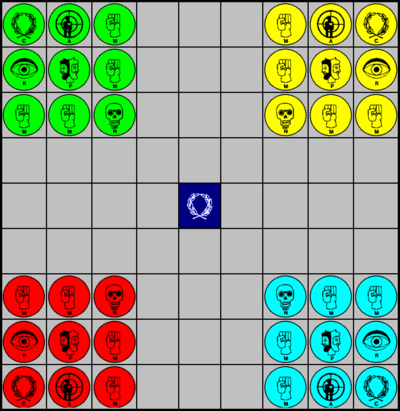Djambi
Djambi (also described as "Machiavelli's chessboard") is a board game and a chess variant for four players, invented by Jean Anesto in 1975.

Rules
Material
The game is played on a 9×9 board whose central square (called "the maze") is marked with a different color or a sign. Each player has 9 pieces:
- 1 Chief
- 1 Assassin
- 1 Reporter
- 1 Troublemaker (also called Provocateur, or Diplomat)
- 1 Necromobile
- 4 Militants.
Objective
The objective of the game is to capture the chiefs of the other players before they capture yours. Although informal alliances can be temporarily agreed upon, there is no team: each player plays against the other players.
Start position
The pieces are placed in each corner of the board as shown in the picture above.
Movements
Each player, at his/her turn, moves one of his/her pieces, and can possibly capture a piece in this way. The militants move of one or two squares in the eight directions; the other pieces can move through any number of squares in the eight directions. A piece cannot jump above another piece.
Captures
The pieces are "killed" as soon as they are captured, but their "corpses" stay on the board (the pieces are turned upside down to show that they are "dead"). The militant kills by occupying the square of a piece (capture by replacement). He places the corpse on an unoccupied square of his choice, except on the central square (the "maze"). A militant cannot kill a chief in power (see below).
- the chief kills and places the corpse in the same way as the militant.
- the assassin kills in the same way as the militant, but places the corpse in the square he comes from.
- the reporter kills by occupying one of the four squares next to the square of the piece he wants to kill (he cannot kill diagonally). The corpse stays in his square. The reporter can only kill at the end of his move.
The troublemaker and the necromobile cannot kill the other pieces but can move them.
- the troublemaker can move another living piece by occupying its square (of course, he can only move the pieces of the other players). The piece is placed on any unoccupied square (except the maze if this piece is not a chief).
- the necromobile acts like a troublemaker but only with the dead pieces (whatever the origin of the dead piece is). The corpses cannot be placed in the maze.
Death and surrounding of a chief
When a player kills the chief of another player, he/she takes control of the living pieces of this one. At his/her turn, he/she will have the choice between using one of his/her own pieces, or using one of the captured pieces. When a player has no necromobile and his chief is surrounded by corpses, he is eliminated (except if he is in power, in the maze). His/her pieces now belong to the chief in power. If there is no chief in power, then the pieces cannot be moved or killed, until the moment when a chief takes the power, and captures them in that way (he keeps control on these pieces even if he leaves the maze).
The maze
The central square of the board is called the maze. Each piece can go through this square, but the chief is the only piece that can stop on it. A chief who is in the maze is a chief "in power". He plays one time after each player. For instance, if there are four players, he plays three times in a turn (if there are two players, he plays twice consecutively). When he leaves the maze, he loses this power. A chief in power takes control of the pieces of the surrounded chiefs, and keeps them after losing the power. A chief in power cannot be killed by a militant. The surrounding has no effect on him. When an assassin, a troublemaker or a necromobile goes in the maze to kill or move a chief, the assailant must make an additional move immediately, in order to leave the maze.
Alliances and betrayals
There can be informal agreements or alliances between the players, but there is no rule to prevent any betrayal.
End of the game
The game ends when a player has captured the chiefs of all of the other players.
Variants
Three-player variant
The pieces of the missing fourth player are "hostages". These pieces can be killed or moved by the pieces of the players. When the chief is captured, the normal rules to take control of them apply. The hostage chief can be placed in the maze, but it has no influence on the game.
Five-player variant
There is a five-player variant of djambi, called pentachiavel.